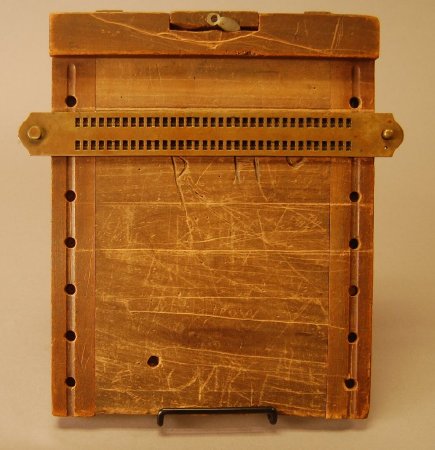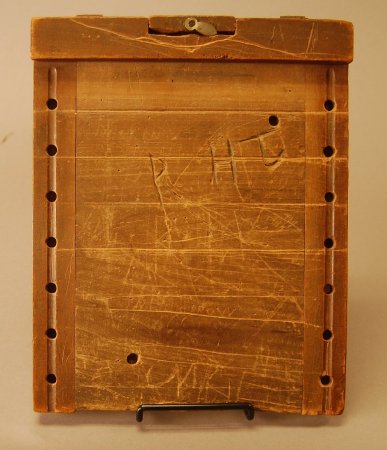Object ID:
2003.185.124a-b
Title:
Braille desk interlining slate with board
Description:
2003.185.124a - Swivel-style interlining desk slate made of brass with two (2) lines of 35 braille cells; rounded points on both ends of frames; single hole through both frames below the right hand peg; cell divider is slightly recessed between every five cells; two pegs on the back fit into the holes in the board; a blunt peg on the front right secures the slate in a closed position; tool marks evident on long edges of both frames. 2003.185.124b - Wooden desk slate; two solid wood side rails, tongue and grooved to main board; each rail has seven (7) 5/16" diameter holes bored in a vertical line and set into a recessed groove that runs from the base and stops just short of the paper clamp; wooden full width paper clamp at top of board, hinged with two brass curled piano hinges, cutout in center of clamp for fixed block mounted with nickel-plated brass leaf-shaped clamp lock, clamp has steel teeth both up and down (total of four); initials, "RHT" are carved into the front along with numerous other illegible markings; "MYRTLE" carved on back of the board.
Date:
ca. 1920
Made by:
National Institute for the Blind
Place of Origin:
London, England
Provenance:
Item was removed from the KSB History Room.
The British & Foreign Association for the Blind, founded in 1868, was listing large and small interlining frames for braille as early as 1882. The "BA" became the National Institute for the Blind in 1914. Braille slates were difficult to find in the U.S. prior to 1900 and British slates were imported by some schools. In 1920, NIB expanded its mandate to include the production and sale of "Apparatus for Use by the Blind" and produced its first catalog soon after.
The British & Foreign Association for the Blind, founded in 1868, was listing large and small interlining frames for braille as early as 1882. The "BA" became the National Institute for the Blind in 1914. Braille slates were difficult to find in the U.S. prior to 1900 and British slates were imported by some schools. In 1920, NIB expanded its mandate to include the production and sale of "Apparatus for Use by the Blind" and produced its first catalog soon after.
Credit Line:
Gift of the Kentucky School for the Blind, 2003.185

